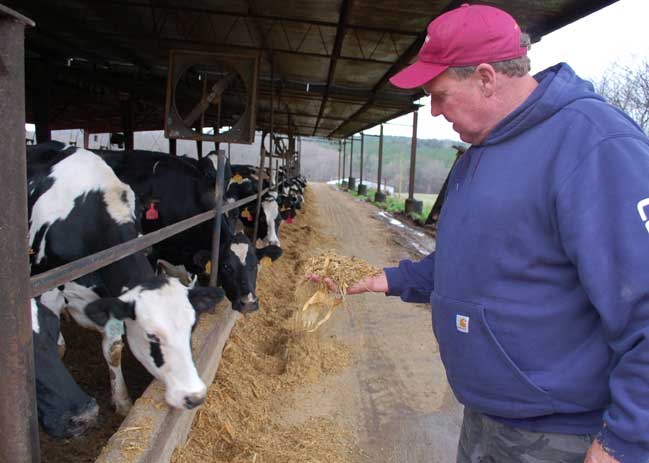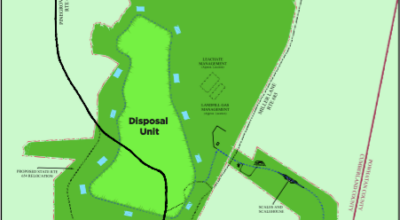Poorhouse Dairy wins clean water award
Published 4:54 pm Thursday, February 4, 2016

- Robert M. “Bobby” Jones, who owns and operates Poor House Dairy Farm near Farmville, feeds his dairy cows. Jones won one of 10 Virginia Clean Water Farm Grand Basin Awards this year.
Poor House Dairy — consisting over 1,200 acres filled with dairy cows and hundreds of acres of crops — has won a Virginia Clean Water Farm Grand Basin Award.
The farm, located just east of Farmville, which is owned and operated by Robert M. “Bobby” Jones, is one of only 10 across the state that received one of the awards.
Jones’ farm was nominated by the Piedmont Soil and Water Conservation District (PSWCD), according to the Virginia Department of Conservation and Recreation (DCR), which sponsors the award program.
Poor House Dairy is one of two remaining dairy operations in Prince Edward County, and contributes “nutritional food to local and regional markets while making every effort to minimize negative impacts on the environment,” according to a press release from the PSWCD.
“These farms represent the best in conservation farming in Virginia,” DCR Director Clyde Cristman said. “By voluntarily implementing practices such as stream fencing, cover crops, riparian buffers, nutrient management plans and more, these producers are not only improving conditions on their properties, but they’re also improving conditions for people who live downstream.”
According to the PSWCD, the awards recognize farmers who implement conservation practices and do their part to preserve water quality.
“I’m glad to be classed with people like that who are making the efforts to improve our water quality,” Jones said.
Of the 500 cows on the farm, 200 are milked daily, Jones said. He milks cows twice a day 365 days a year. “They came in today we averaged 78 pounds [of milk] a cow, which relates to about 9-gallons-per cow a day.”
“Two-hundred-and-ninety-two acres of current-day Poor House Dairy were purchased in 1874 by the Prince Edward County Board of Supervisors for a farm where the indigent could be sent to live and work,” the PSWCD release stated. “The poorhouse was in operation raising tobacco, corn, wheat, oats and livestock until it was sold in 1941. Bobby’s father purchased the property in the 1950s and operated the dairy with his son, who inherited the farm. …”
Jones — a member of the county’s board of supervisors — works with natural resource partners “so that all necessary best management practices (BMPs) can be put into operation on the farm,” the district stated. “Poor House Dairy operates under a current Comprehensive Nutrient Management Plan through [the] United States Department of Agriculture’s (USDA) Natural Resources Conservation Services (NRCS), the highest level of USDA NRCS planning available. He is a faithful proponent of cover crops, following his grain crops with winter cover to prevent erosion and capture nitrogen. He has installed a loafing lot management system with cost-share assistance through the Piedmont SWCD and USDA NRCS’ EQIP program that includes a milking parlor, free-stall barn, concrete liquid manure tank, pack barn, grazing paddocks with waterers, travel lanes and hardened stream crossings.”
According to the release, the area where the cows are milked is designed to make it possible to manage the livestock’s liquid and solid wastes in a manner that reduces its impact on surface and groundwater while generating a source of fertilizer for cropped areas.
Jones’ dry cows — heifers not yet bred — and calves to be sold are fed and rested in either a pack barn he built in 2012, or several grazing paddocks, depending on weather and other factors.
“The pack barn is a covered facility with low sidewalls for ventilation. It is filled with a deep layer of sawdust to act as bedding and as a medium of compost for the animal wastes. The sawdust pack is periodically turned to introduce air into the system to increase composting speed,” the release stated.
Jones has voluntarily installed over 7,700 feet of cattle exclusion fencing to help improve water quality and improve the health of his herd.
“It wasn’t unusual at all, years ago, for the waste from the milking parlor to have a drain that shot right out the back door and right to the creek it went,” Jones said. “People didn’t realize at the time how much damage they were doing. That was the convenient way of getting rid of waste.”
Jones has a three-quarters-of-a-million gallon lagoon that stores manure from the cows. Rather than spreading it on the fields during the winter and wet times of the year, he waits until the “optimal time for the plants to take up the nutrients and not have the runoff all winter long.”
Jones’ dairy farm has been the site of trainings and tours, including several engineering trainings through the PSWCD and NRCS.
According to the district, his conservation practices and dedication to protecting natural resources make him a role model for producers across the state.
“Somebody’s up here in the morning at 3:30 a.m. and we go till about 7:30 p.m., sometimes until 8 p.m. at night,” Jones said of his operation.
“As the saying goes, when the sun shines, you’ve got to make hay.”





